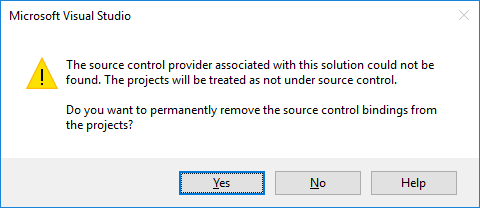I’ve blogged a while back on how SSIS 2017 was finally here. Not much has changed; there is still no Visual Studio extension for SSIS, so if you want to create SSIS projects you still need to install SQL Server Data Tools (which makes it a bit useless that there are SSRS and SSAS extensions).
At my current client we are migrating to SQL Server 2017, so happy as I am I downloaded SSDT for Visual Studio 2017 (currently in the 15.4.0 preview version). I was happy because
- I could use Visual Studio 2017
- I didn’t need a full-blown Visual Studio, since there is a TFS Source Control Explorer for Visual Studio 2017 (VS 2015 doesn’t have this)
So I installed SSDT and the TFS plug-in. I configured the connection to the TFS server and the mapping and downloaded all our project objects. Then I tried to open an SSIS project. I was greeted with the cheerfully “The source control provider associated with this solution could not be found. The projects will be treated as not under source control.
Do you want to permanently remove the source control bindings from this project?“. Euh, what?

Turns out, the latest version of SSDT for VS 2017 breaks the TFS mappings. Happy days. Here’s a whole thread of people with the same issue. Also for giggles, check out the comments at the download page of SSDT. Of course there’s no older version available for VS 2017, only for VS 2015 or 2013. Funny, that download page says:
“The last few downloads are provided for the unlikely event that you experience issues with the latest release.”
Unlikely event?

So I removed SSDT and the TFS plug-in. I installed the full-blown Visual Studio (not happy, but you can choose which parts to install so you can go for a very light-weight install. Still not free like SSDT) and then I installed the SSDT 15.4.0 preview again. Finally, I removed the SSRS extension (version 1.17) and installed the last version (1.19). This time, the TFS integration seems to work fine. Another option would be to downgrade to Visual Studio 2015, but then again, there you also need the full Visual Studio for TFS integration.
On a sidenote: every time you close a solution in VS 2017, the annoying start page pops up. There’s a thread on StackOverflow on how to disable this (hint: it involves the registry).
Moral of the story: even Microsoft doesn’t know how to do integration testing. 


